Georgia WWSCAN biweekly update 5/26/23
Welcome to the bi-weekly update for WWSCAN partners in Georgia! All samples provided up through 5/22/23 have been processed and data are on the site at data.wastewaterscan.org.
If you notice any bugs on the new site or have any comments about it, please continue to send your feedback via email Amanda Bidwell at albidwel@stanford.edu. We are extremely grateful for your partnership!
Infectious Disease Target Review
Below is a quick reminder of all the targets that we currently monitor for:

The methods for our assays are in the public domain. You can access them using these QR codes:

COVID-19
SARS-CoV-2 and Variants
SARS-CoV-2 N gene RNA concentrations are still low at most Georgia sites but have slightly increased in comparison to two weeks ago at the Little River plant. Concentrations approximately range from 16,000 copies per gram to 130,000 copies per gram. Clicking on a chart image will take you directly to the WWSCAN website to interact with a chart.
There are a couple new features that were recently launched on the site. The first is a dark gray population-weighted aggregated trend line for multiple selected locations when the data is normalized by PMMoV. It is calculated using the population-weighted trimmed smoothed average for each selected site and can be used for any target. Further information on the methodology behind this trend line can be found here under the section "How are aggregated trendlines determined?" To add it to a chart, click the "view" icon next to "All Selected Locations (Average)" on the options to the left of each chart.

For recent trends for each pathogen (concentrations normalized by PMMoV) we test for linear trends between log10-transformed concentration (target/PMMoV) and time; the trend must be classified as statistically significant (p<0.1). You can read about our methods for trend analysis here. For SARS-CoV-2, of 8 sites in Georgia, 1 shows an upward trend, and 7 show no trend.
Early in 2023, WWSCAN started testing for XBB* and these results are now available to view by selecting 'SARS-CoV-2 View by Variant' on data.wastewaterscan.org. For Georgia sites, data dates back to early February 2023. A newly added feature provides a variant compare chart option for all SARS-CoV-2 variants in addition to the line and heat map charts. It allows you to view the ratio of SARS-CoV-2 variant mutations/N gene. You can compare either SARS-CoV-2 variants for a single location or by selecting multiple locations such as the Georgia regional grouping.
The ratio of the XBB* mutations/N across all Georgia plants is shown in the chart below. As the ratio reaches 100%, it suggests that all the SARS-CoV-2 genomes in wastewater have the XBB* mutations. These data indicate that the average ratio XBB* mutations/N is ~75% but has ranged from 40-100% recently. This suggests the majority of infections across the communities are caused by XBB*. The next chart below shows the ratio of the BA.5, BA.4, and BQ* mutation/N across all Georgia plants. It can be read the same way as the XBB* chart. The average ratio is close to 0%. Note that our XBB* assay will also detect XBB.1.16, XBB.1.9, and FD.2 (XBB.1.5.15.2*).


Other Respiratory Viruses
IAV, IBV, RSV, and HMPV
Influenza A (IAV) RNA has been detected sporadically across Georgia sites in the last two weeks. IAV concentrations remain low, which is similar to two weeks ago. For all 8 sites in Georgia, there is no significant trend over the past 21 days.
When samples are non-detect, this means that the amount of viral RNA in the wastewater is below the limit of detection of our methods. This means that there are likely very few people shedding that pathogen into wastewater in these communities. In the heat maps below, each plant is represented by a row (y-axis), and dates are shown along the x-axis. Blue indicates a non-detect and darker orange/red is proportional to concentration with the highest values being the darkest. A white means no sample was collected.
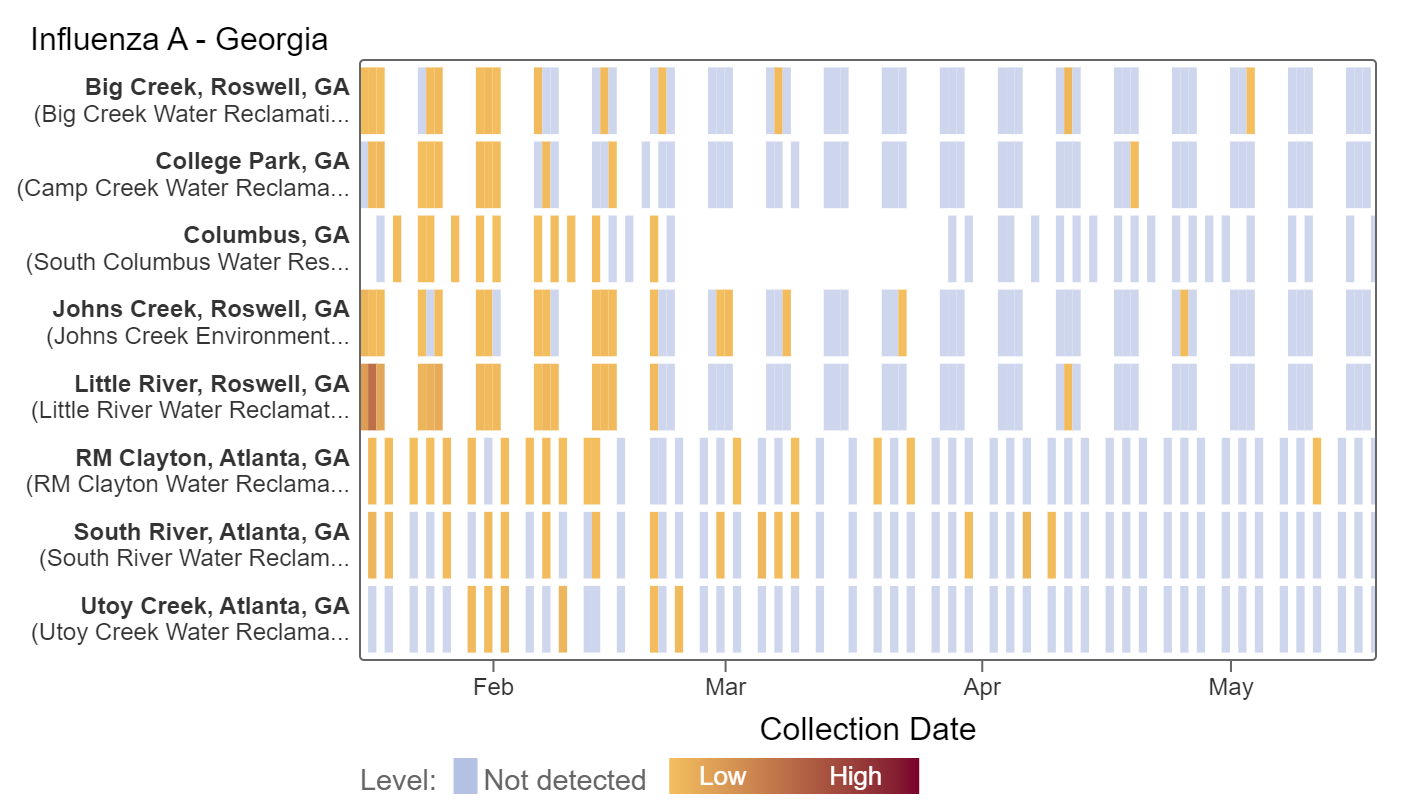
Influenza B (IBV) RNA concentrations are low with values less than 14,000 copies/g and detections are sporadic but regular across Georgia sites since the end of February. Within the last month, all sites have detected IBV at least once.

RSV RNA concentrations remain very low with detected values less than 3,000 copies/g in some samples within the last two weeks. Sites where RSV has not been detected in samples collected within the last two weeks include Columbus, Little River, South River, and Utoy Creek. For all 8 sites in Georgia, there is no significant trend over the past 21 days.
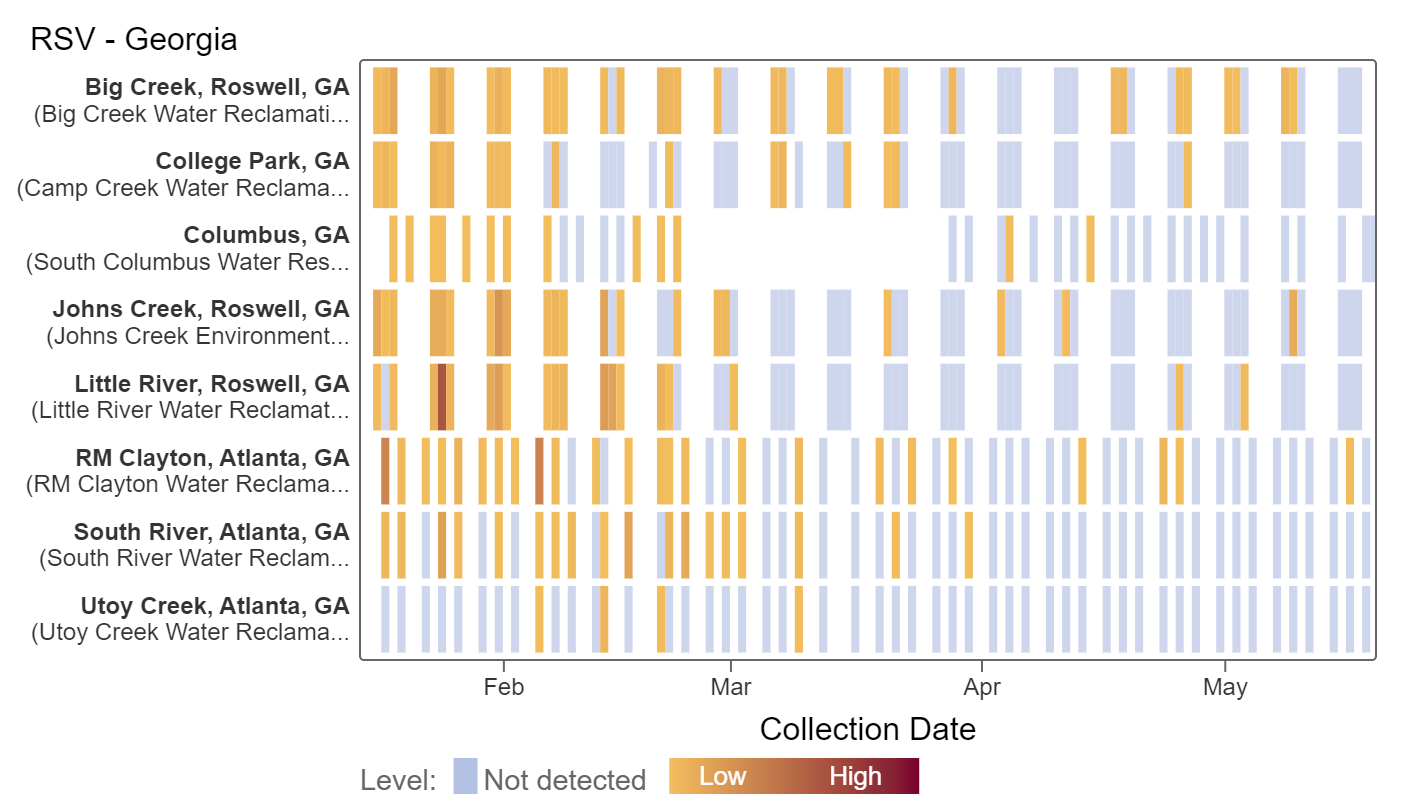

HMPV (human metapneumovirus) RNA concentrations remain constant. For two weeks, HMPV values have been less than 25,000 copies/g. South River and Utoy Creek are the only sites that have not detected HMPV in their samples over the last two weeks. For 8 sites in Georgia, 1 shows an upward trend (RM Clayton), and 7 show no trend.
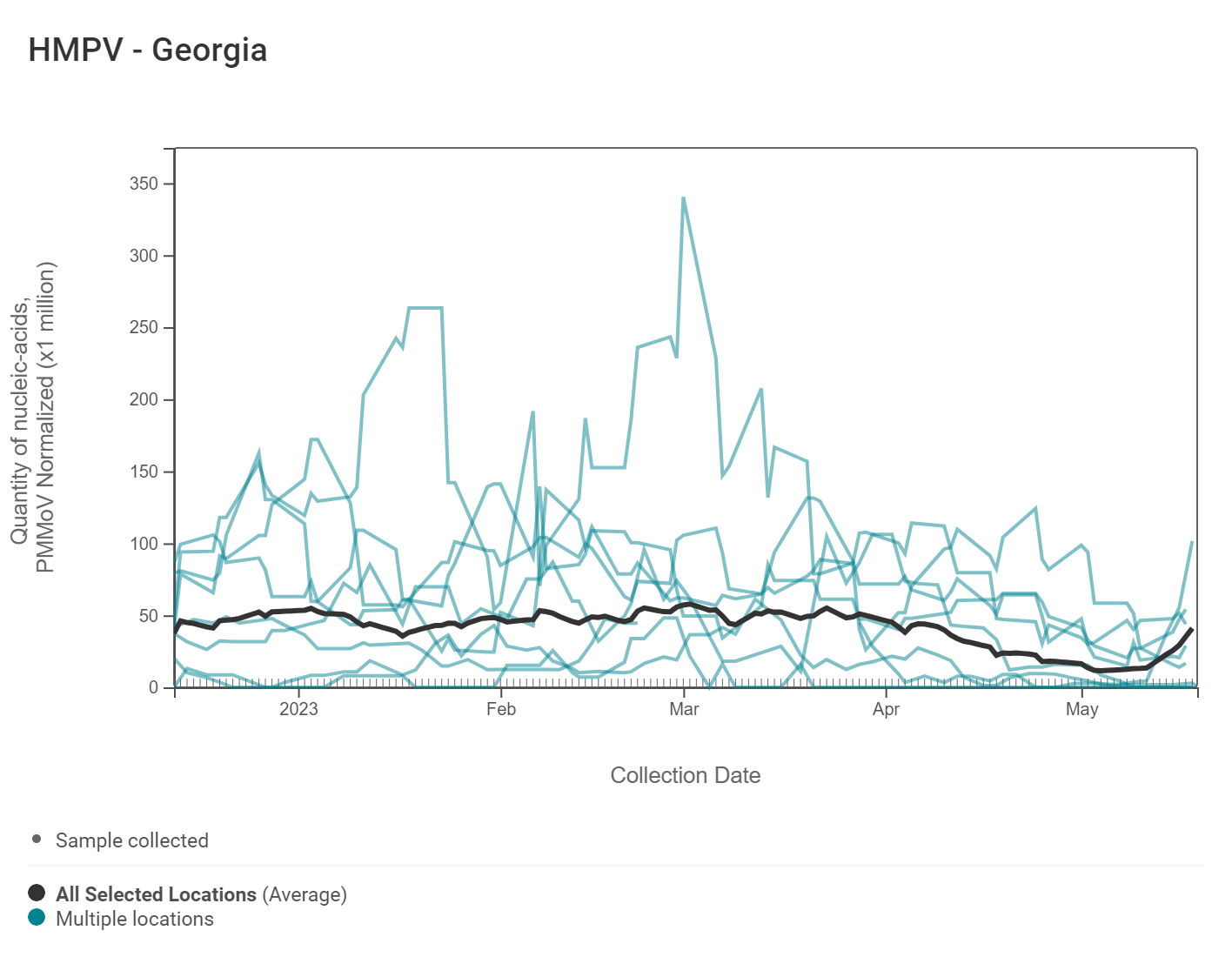
Norovirus
Assay detects human norovirus GII
Norovirus GII (HuNoV GII) RNA concentrations range from 4,000,000 - 16,000,000 copies/gram. For all 8 sites in Georgia, there is no significant trend over the past 21 days.
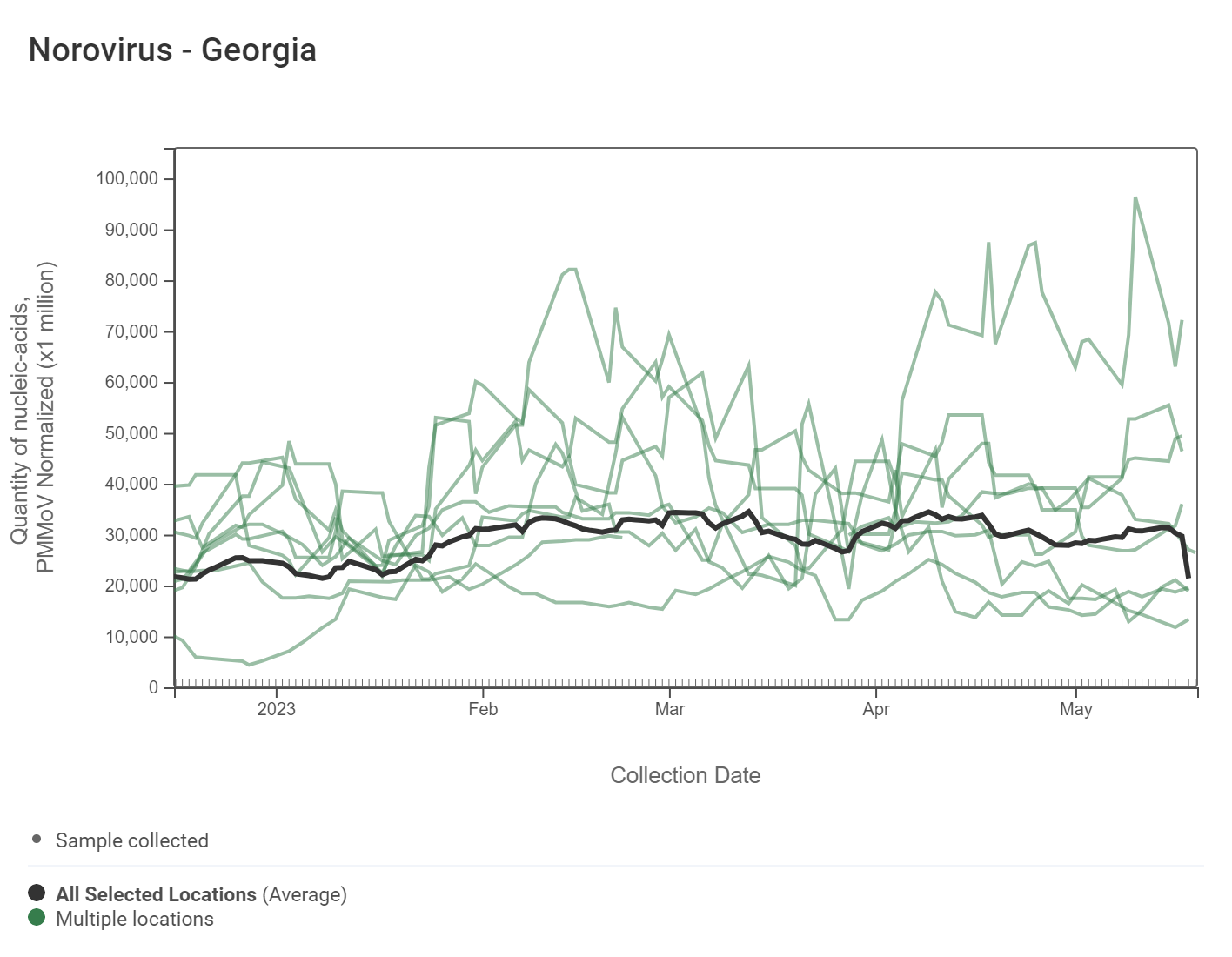
Mpox
Results continue to remain non-detect for mpox at all Georgia plants. This heat map shows data since July 2022. Sites are labeled in the rows and each date a sample was collected as a column. Again, the color blue means the sample was non-detect for mpox DNA and the colors get darker with higher concentrations. As a reminder, you can access our paper in New England Journal of Medicine about how mpox wastewater monitoring compares to clinical reports of infectious here.
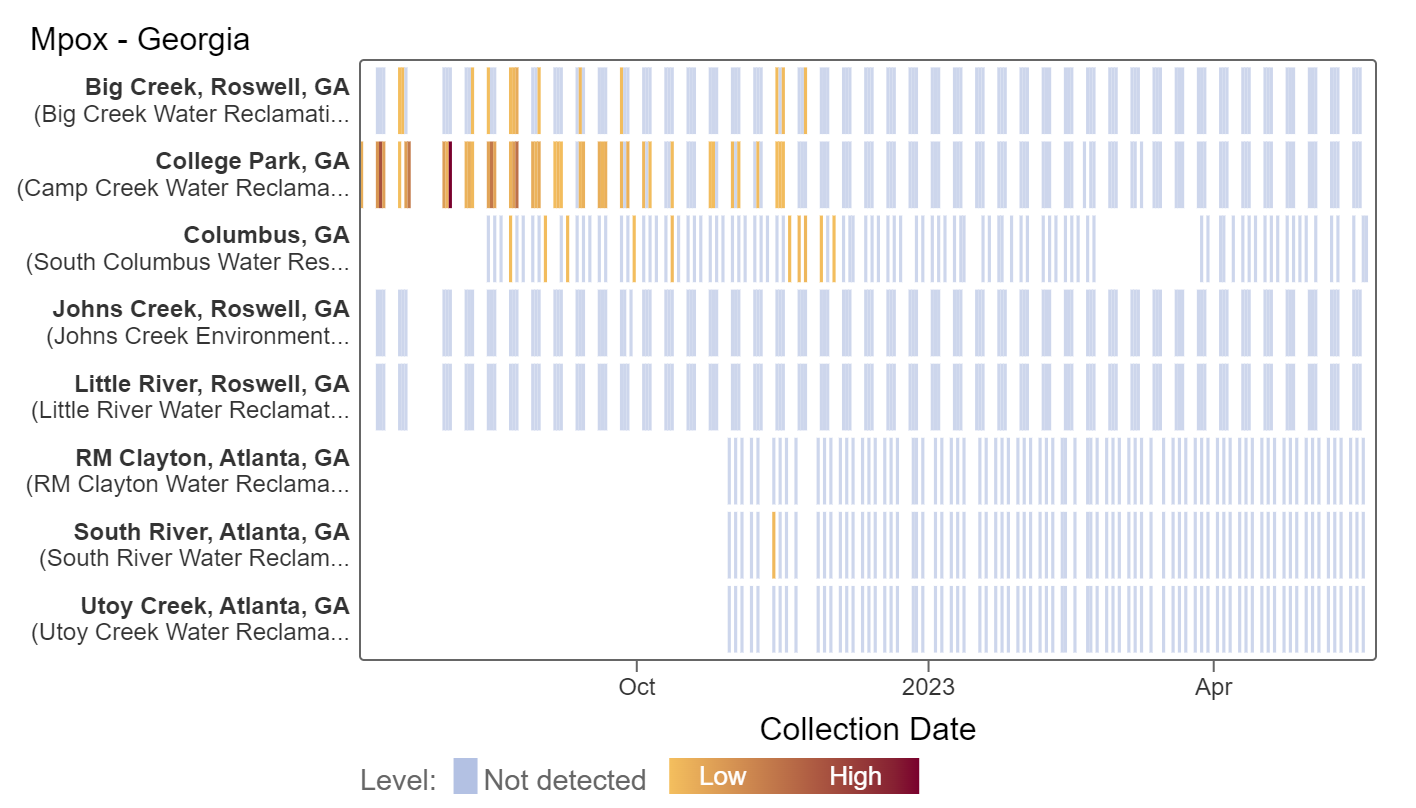
Related News
Dr. Wolfe will be in Houston for the ASM Microbe Conference in mid-June; please reach out if you will be there.
The next WastewaterSCAN Stakeholder Meeting will take place June 9th at 12 PM EST. Hope to see you there!
We'll send out the usual update in advance of the meeting and will be taking the time to focus on demonstrating different features of the website and answering questions about its use. If you have questions about the website or anything else, submitting them in advance here will help us plan to address everything.
